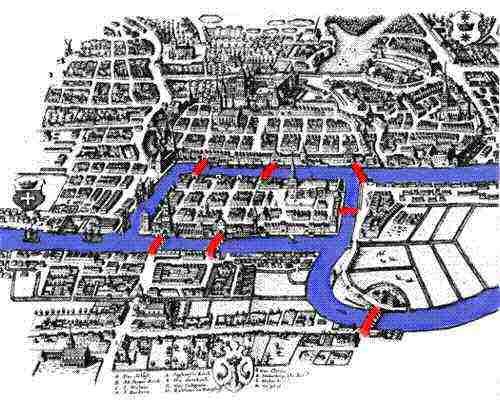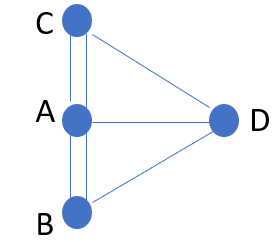Introduction
Graphs, or networks, are useful for representing relationships from social network,maps, the internet, and the universe. In this post, we start with the humble beginning of graph theory from the problem of proving it is not possible to cross each of the 7 bridges of Konigsberg once and only once, and go over its three presentations, and implementating a graph object.
In this post, we will go over three representations of network: mathematical set, adjacency list, and adjacency matrix.
Types of graphs
- Undirected graphs. E.g.,two-way streets
- Directed graphs (Digraph). E.g., Instagram followers and influencers
- Weighted graphs, where edges have varied weights, such as credit risk transition matrix
- Special graphs: trees, rooted tree, directed acyclic graphs (DGA)
tree is undirected connected graph with no cycles. One other definition relating tree to graph is: a graph is a free tree iff there exists a unique path between every pair of nodes. A tree with \(N\) nodes has \(N-1\) edges.
A rooted tree (often simplily referred to as “tree”) is a tree with a root node where either all edges point towards the root node (“out-tree”) or away from it (“in-tree”). For example, max and min heaps.
DGAs are directed graphs with no cycles. DAGs are used to represent structures with dependencies. All out-trees are DAGs but all DAGs are out-trees.
Bipartite graph: a graph that can be split into two groups such that every edges is a link between the two groups (male and female among the heterosexual, job seekers and jobs)
Complete graph is fully connected where every node is connected to every other node.
Representations
Mathematical set representation
The mathematical set representation is also called “edge list”. Tt is conceptually simple, although it is not often used in computer implementation because of the lack of structure.
In mathematics, graph is a pair of two sets:
where \(V\) is the set of nodes, and \(E\) is the set of edges.
For example,
\[V=\{0, 1, 2, 3\}\] \[E=\{(0, 1),(0, 2), (0, 3),(2, 3)\}\]Image and quote below from MAA “Leonard Euler’s Solution to the Konigsberg Bridge Problem”
 ;
;
“According to lore, the citizens of Königsberg used to spend Sunday afternoons walking around their beautiful city. While walking, the people of the city decided to create a game for themselves, their goal being to devise a way in which they could walk around the city, crossing each of the seven bridges only once. Even though none of the citizens of Königsberg could invent a route that would allow them to cross each of the bridges only once, still they could not prove that it was impossible.”
Euler was not only famous for being a mathematician, but also for his notations, how he represented the problems using symbols to simplify problem (to help mental process) as shown in his own scketch.
 We will use graph representation on Euler’s 7 bridge problem. A, B, C, D are the names of regions.
We will use graph representation on Euler’s 7 bridge problem. A, B, C, D are the names of regions.
A set is a collection of unique elements. The set of \(E\) is called a multi-set because it contains “duplicates”.
Use namedtuple is a natural choice for coding graph objects in Python.
from collections import namedtuple
Graph = namedtuple("Graph", ["vertice", "edge"])
V = ['A','B', 'C', 'D']
E =[
('A','B'),
('A','B'),
('A','C'),
('A','C'),
('A','D'),
('B','D'),
('C','D'),
]
# W= [0.1, 0.1, 0.1, 0.1,0.1, 0.1,0.4]
G = Graph(V ,E)
# G = Graph(V ,E, W)
print(G)
# Graph(vertice=['A', 'B', 'C', 'D'], edge=[('A', 'B'), ('A', 'B'), ('A', 'C'), ('A', 'C'), ('A', 'D'), ('B', 'D'), ('C', 'D')], weights=[0.1, 0.1, 0.1, 0.1, 0.1, 0.1, 0.4])
adjacency list representation
Adjacency list groupbys the nodes and lists out their immediate neighbors. In other words, it maps from nodes to lists of edges.
\[A: B, B, C, C, D\] \[B: A, A, D\] \[C: A, A, D\] \[D: A, B, C\]Below code uses Python dictionary to store the adjacency list representation of the graph.
Note that using dictionary (a hash table) has limitation: Because dictionary keys have to be hashable, this means that list, and user-defined classes cannot be used as keys. Therefore, this limits our nodes cannot be list or user-defined classes.
adjacency_dict = {'A': ['B', 'B', 'C', 'C', 'D'],
'B': ['A', 'A', 'D'],
'C': ['A', 'A', 'D'],
'D': ['A', 'B', 'C']}
# Graph(vertice=['A', 'B', 'C', 'D'], edge=[('A', 'B'), ('A', 'B'), ('A', 'C'), ('A', 'C'), ('A', 'D'), ('B', 'D'), ('C', 'D')])
def adjacency_dict(graph):
"""
Returns the adjacency list representation of graph
"""
adj = {vertice:[] for vertice in graph.vertice}
print(adj)
for edge in graph.edge:
V1, V2 = edge[0], edge[1]
adj[V1].append(V2)
adj[V2].append(V1)
return adj
aG = adjacency_dict(G)
print(aG)
If our source data for the nodes and edges is a pandas DataFrame using mathematical set representation, we can use df.groupby(‘vertice’)[‘edge’].apply(list) to quickly convert it to adjacency list representation.
Adjacency matrix representation
Adjacency matrix representation looks very much like a square transition matrix.
\(\|V\|\times\|V\|\) Boolean-valued matrix indexed by nodes, with \(1\) indicating edge or connection.
The time and space complexity of a graph We put a 1 (or weight, or the number of times they are connected) in the (i,j) cell for edges , and 0 for no connection.
In the code below, we use pandas to handle the indexing.
- Read in list of edge tuples to a DataFrame
- Copy the DataFrame from step 1 with columns flipped. However, the names should follow the first DataFrame’s order.
- Concatenate the 2 DataFrames, and crosstab to get the count
- (Optional) Re-index both columns and row index in order to get rid of the old names
import pandas as pd
df1 = pd.DataFrame(E, columns = ['V1','V2'])
df2 = df1[['V2','V1']].copy() # copy but with columns flipped because of undirected graph has symmetry
df2.columns = ['V1','V2']
df = pd.concat([df1, df2], axis=0)
df = pd.crosstab(df.V1,df.V2)
df.columns = V
df.index = V
print (df)
# A B C D
# A 0 2 2 1
# B 2 0 0 1
# C 2 0 0 1
# D 1 1 1 0
If we don’t use pandas, we would have to re-code the list of tuples of edges from letters to integers because list indexing cannot be letters. Alternatively we can use the Python built-in functions ord and chr. But I think using pandas requires less coding.
Convert set representation to adjacency matrix
from collections import namedtuple
Graph = namedtuple("Graph", ["vertice", "edge"])
V = ['A','B', 'C', 'D']
E = [
(0, 1),
(0, 1),
(0, 2),
(0, 2),
(0, 3),
(1, 3),
(2, 3)
]
G = Graph(V,E)
print(G.vertice)
# ['A', 'B', 'C', 'D']
def adjacency_matrix(graph):
adj = [[0 for i in graph.vertice] for j in graph.vertice]
for edge in graph.edge:
V1, V2 = edge[0], edge[1]
adj[V1][V2] += 1
adj[V2][V1] += 1
return adj
print(adjacency_matrix(G))
Convert matrix to adjacency list
from collections import defaultdict
from pprint import pprint
graph = defaultdict(list)
edges = set()
for i, v in enumerate(X.tolist(), 1): # X is a matrix
for j, u in enumerate(v, 1):
if u != 0 and frozenset([i, j]) not in edges:
edges.add(frozenset([i, j]))
graph[i].append({j: u})
pprint(graph)
Directed graphs
Directed graphs have one-way directions.
We rewrite the Graph nametuple and functions above to add is_directed parameter.
from collections import namedtuple
Graph = namedtuple("Graph", ["vertice", "edge", "is_directed"])
G = Graph(vertice = range(3), edge = [(1,0),(1,2), (0, 2)],is_directed= True)
def adjacency_dict_directed(graph):
"""
Returns the adjacency list representation of graph
"""
adj = {vertice:[] for vertice in graph.vertice}
print(adj)
for edge in graph.edge:
V1, V2 = edge[0], edge[1]
adj[V1].append(V2)
if not graph.is_directed:
adj[V2].append(V1)
return adj
adjacency_dict(G) # undirected because we use the function defined regardless of directed
# {0: [1, 2], 1: [0, 2], 2: [1, 0]}
aG = adjacency_dict_directed(G)
print(aG)
# {0: [2], 1: [0, 2], 2: []}
def adjacency_matrix_directed(graph):
"""
Returns the adjacency list representation of graph
"""
adj = [[0 for i in graph.vertice] for j in graph.vertice]
print(adj)
for edge in graph.edge:
V1, V2 = edge[0], edge[1]
adj[V1][V2] += 1
if not graph.is_directed:
adj[V2][V1] += 1
return adj
adjacency_matrix(G)
# [[0, 1, 1], [1, 0, 1], [1, 1, 0]]
adjacency_matrix_directed(G)
# [[0, 0, 1], [1, 0, 1], [0, 0, 0]]
Comparisons of representations
Adjacency list is more compact, and saves space for sparse graph. But adjacency list is slow for dense graphs.
Adjaceny matrix takes up \(O(\|V\|^2)\) space, regardless how dense the graph. Iterating over all edges takes \(O(\|V\|^2)\) time. But the adjaceny matrix is \(O(1)\) for edge weight lookup, and is faster than adjacency list for dense graphs. It is also simpler representation.
Implementation
undirected graph
The implementations using adjacency list and adjacency matrix. Each has two classes Node (for a single point or node) and Graph.
The Node class has attributes: its name, and its neighbors, and a function for adding neighbor.
The Graphx class defines nodes and edge_indices, each with a dictionary, and edges in a list. The class has 3 methods: add_node, add_edge and print_graph.
When adding English letter nodes in the Graph object we define, we use the range function with two other built-in functions: ord and chr to convert letter to unicode, and from unicode back to character.
For example,
ord('A')
# 65
ord('B')
# 66
chr(ord('A'))
# 'A'
We first verify that the node to be added is not already in the code.
class Node: # could call it class V but it seems too short
def __init__(self,n):
self.name = n
self.neighbors = list()
def add_neighbor(self, v):
if v not in self.neighbors:
self.neighbors.append(v)
self.neighbors.sort()
class Graph:
nodes = {}
def add_node(self, node):
if isinstance(node, Node) and node.name not in self.nodes:
self.nodes[node.name] = node
return True
else:
return False
def add_edge(self, u, v, weight = 1):
if u in self.nodes and v in self.nodes:
for key, value in self.nodes.items():
if key == u:
value.add_neighbor(v)
if key == v:
value.add_neighbor(u)
return True
else:
return False
def print_graph(self):
for key in sorted(list(self.nodes.keys())):
print(key + str(self.nodes[key].neighbors))
# test code
a = Node('A')
g = Graph()
g.add_node(a)
g.add_node(Node('B'))
for i in range(ord('A'), ord('K')):
g.add_node(Node(chr(i)))
edges = ['AB','AE', 'BF', 'CG', 'DE', 'DH','EH', 'FG','FI', 'FJ','GJ','HI']
for edge in edges:
g.add_edge(edge[:1], edge[1:])
g.print_graph()
# A['B', 'E']
# B['A', 'F']
# C['G']
# D['E', 'H']
# E['A', 'D', 'H']
# F['B', 'G', 'I', 'J']
# G['C', 'F', 'J']
# H['D', 'E', 'I']
# I['F', 'H']
# J['F', 'G']
class Node:
def __init__(self,n):
self.name = n
self.neighbors = list()
def add_neighbor(self, v):
if v not in self.neighbors:
self.neighbors.append(v)
self.neighbors.sort()
class Graph:
nodes = {}
edges = []
edge_indices = {}
def add_node(self, node):
if isinstance(node, Node) and node.name not in self.nodes:
self.nodes[node.name] = node
for row in self.edges:
row.append(0) # add rows of zeros
self.edges.append([0]*(len(self.edges) + 1)) # add columns of zeros
self.edge_indices[node.name] = len(self.edge_indices)
return True
else:
return False
def add_edge(self, u, v, weight = 1):
if u in self.nodes and v in self.nodes:
self.edges[self.edge_indices[u]][self.edge_indices[v]] = weight
self.edges[self.edge_indices[v]][self.edge_indices[u]] = weight
return True
else:
return False
def print_graph(self):
for v, i in sorted(self.edge_indices.items()):
print(v + ' ', end= '')
for j in range(len(self.edges)):
print(self.edges[i][j], end='')
print(' ')
# test code
g = Graph()
a = Node('A')
g.add_node(a)
g.add_node(Node('B'))
for i in range(ord('A'), ord('K')):
g.add_node(Node(chr(i)))
edges = ['AB','AE', 'BF', 'CG', 'DE', 'DH','EH', 'FG','FI', 'FJ','GJ','HI']
for edge in edges:
g.add_edge(edge[:1], edge[1:])
g.print_graph()
# A 0100100000
# B 1000010000
# C 0000001000
# D 0000100100
# E 1001000100
# F 0100001011
# G 0010010001
# H 0001100010
# I 0000010100
# J 0000011000
